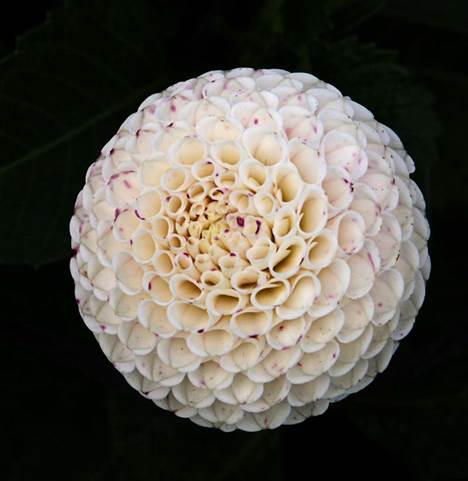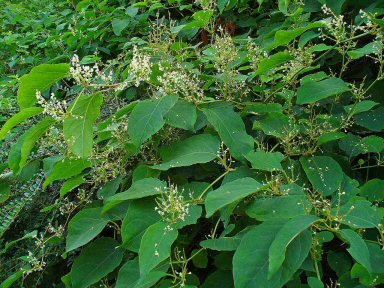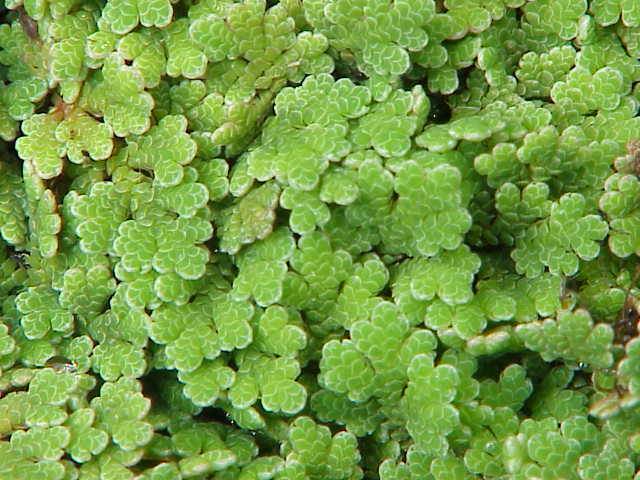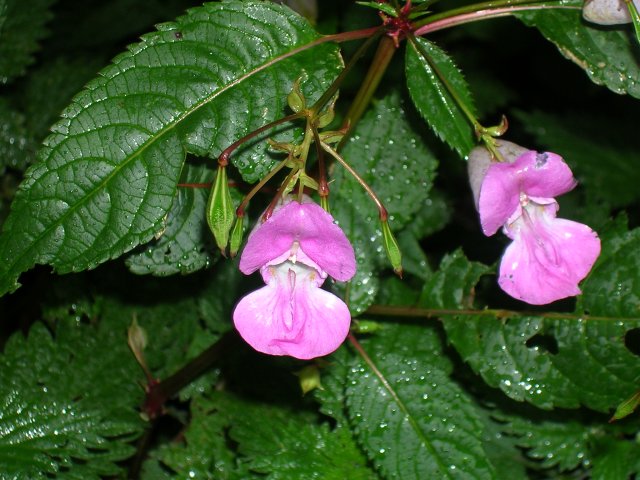- Home
- Practical Advice
- Plants and planting
- Plants to avoid
Plants to avoid
There are two main reasons to avoid certain types of plants in a wildlife-friendly garden. Some showy flowers should be avoided if your prime concern is to attract and help pollinating insects, although some of these may be of benefit to herbivorous animals, and all when dead will help detritivores. The second, and more serious group is plants which are of national concern because they are invasive and difficult to control.
Flowers to avoid if you want to help pollinators.
For pollinating insects to be able to use flowers they must contain this resource and it must be accessible. Plant breeders naturally aim primarily at producing extremely showy and colourful plants, without reference to their value for insects. Double flowered or “flora pleno” varieties have extra rows of petals and typical examples are ‘Cactus’ and ‘Pompom’ Dahlias, ‘Mophead’ Chrysanthemums, and ‘Hybrid tea’ Roses. They are of little or no use to foraging insects because the modified shape of the flowers usually makes them inaccessible to insects, and the extra rows of petals often replace the stamens and nectaries that were originally present and are the parts of the flower that provide pollen and nectar.



Three highly-bred flowers of little use to pollinators, from the left, Hybrid Tea rose "Biedermeier", Pompon Dahlia 'Small World', Snowdrop Galanthus nivalis 'flore pleno'
Bedding Plants are highly hybridised annuals used in hanging baskets and tubs and planters. They are the result of breeding to create strains with uniform size, long-lasting flowers, bright colours, and a long retail 'shelf life’. Production of pollen or nectar accessible to insects has generally been lost, which is why we avoid them in wildlife gardens. Typical examples are busy lizzies (Impatiens), Petunia, surfinias (which are a type of Petunia), bedding “geraniums” (Pelargonium hybrids), Nemesia, double flowered ‘French’ and ‘African’ marigolds, Celosia, Begonia, and Ageratum. The brightly coloured winter-flowering Polyanthuses and winter-flowering Viola also fall into this category.
There are a few exceptions. The following kinds of bedding plants are commonly visited by foraging insects: sweet alyssum (Lobularia), single-flowered nasturtiums (Tropaeolum majus), wallflowers (Cheiranthus), Tagetes minuta, and Bidens ferulaefolia, a small yellow flower often used in hanging baskets. Single-flowered forms of ‘French Marigolds’ also provide food for foraging insects, but can be difficult to obtain unless you grow them from seed yourself.
In some parts of the world, especially in the southern hemisphere, many species of plants are not pollinated by insects at all but by birds, or in some cases small mammals. They are generally inaccessible to British pollinating insects. The following genera, common in UK gardens, are typical examples of this group: Fuchsia, Phormium, Callistemon, Crocosmia, Crinodendron, Embothrium, Kniphophia, Canna, Desfontainia and Cuphea. There are some exceptions , and a few varieties of Fuchsia and Kniphophia produce copious amounts of nectar that is collected by honeybees, but it is only the adaptable and adventurous honeybees and the commoner species of bumblebees that are able to exploit these flowers.
Find out more about this issue on our Plants for Pollinators page.
Plants to avoid because they are invasive and difficult to control
The word ‘invasive’ is often teamed up with ‘non-native’ or ‘alien’, implying that there is an association between the two terms. The vast majority of non-native plants grown in UK gardens are not invasive. Conversely there are native plants like bracken, nettles and bramble which are extremely invasive and a problem for gardeners and nature reserve managers.
Nevertheless, there is particular and justified concern about a subset of non-native plants which are causing great concern in Britain and other countries. In the British Isles this is reflected in separate national legislations which prohibit causing any of three nationally divergent set of plants to grow in the wild. The land and freshwater species concerned are listed in the Wildlife and Countryside Act. Note that by no means all these plants are alien to all of Britain. Water Soldier (Stratiotes aloides) which is banned in Northern Ireland is native to Southern England where it is classed as Near Threatened on the Red Data List.
Three invasive aliens introduced in part by horticulturalists and now under legislation. Left to right, Japanese Knotweed, Water Fern and Himalayan Balsam.
This legislation does not prohibit you from growing these species in gardens, but we would advise you not to do this because they may prove difficult to control, and they may spread from your garden into the wider environment. Note that the legislation includes members of the genus Cotoneaster. These are often recommended for wildlife-friendly planting because they provide both forage for insects and berries for birds.
There is special concern about aquatic plants, for there are some very rampant species which can choke ponds and streams. We advise you only to stock ponds with properly identified aquatic plants bought from reputable specialist nurseries. Pond plant advice is available from the GB Non-native Species Directorate.
Invasive Native Plants
The following are examples of common native plants that can be invasive:
- Hogweed Heracleum sphondylium
- Stinging Nettle Urtica dioeca
- Rosebay Willowherb Chamerion angustifolium
- Bramble Rubus fruticosus agg. and hybrids
- Bracken Pteridium aquilinum
- Gorse Ulex species
All of these have value to wildlife, but all are very common outside of gardens and we do not recommend that you plant them unless you have a large garden and are willing to control them if they spread too vigorously.
Some other native species that are often recommended to gardeners because of their attractiveness to wildlife teeter on the edge of ‘invasiveness’ in a garden setting and need regular control by the gardener. We advise you not to grow the following in your garden unless have time to keep them under control
- Teasel Dipsacus fullonum
- Viper’s Bugloss Echium vulgare
- Hemp Agrimony Eupatorium cannabinum
- Ox-eye Daisy Leucanthemum vulgare
Page written by Marc Carlton Reviewed by Steve Head


Plants to avoid
There are two main reasons to avoid certain types of plants in a wildlife-friendly garden. Some showy flowers should be avoided if your prime concern is to attract and help pollinating insects, although some of these may be of benefit to herbivorous animals, and all when dead will help detritivores. The second, and more serious group is plants which are of national concern because they are invasive and difficult to control.
Flowers to avoid if you want to help pollinators.
For pollinating insects to be able to use flowers they must contain this resource and it must be accessible. Plant breeders naturally aim primarily at producing extremely showy and colourful plants, without reference to their value for insects. Double flowered or “flora pleno” varieties have extra rows of petals and typical examples are ‘Cactus’ and ‘Pompom’ Dahlias, ‘Mophead’ Chrysanthemums, and ‘Hybrid tea’ Roses. They are of little or no use to foraging insects because the modified shape of the flowers usually makes them inaccessible to insects, and the extra rows of petals often replace the stamens and nectaries that were originally present and are the parts of the flower that provide pollen and nectar.



Three highly-bred flowers of little use to pollinators, from the left, Hybrid Tea rose "Biedermeier", Pompon Dahlia 'Small World', Snowdrop Galanthus nivalis 'flore pleno'
Bedding Plants are highly hybridised annuals used in hanging baskets and tubs and planters. They are the result of breeding to create strains with uniform size, long-lasting flowers, bright colours, and a long retail 'shelf life’. Production of pollen or nectar accessible to insects has generally been lost, which is why we avoid them in wildlife gardens. Typical examples are busy lizzies (Impatiens), Petunia, surfinias (which are a type of Petunia), bedding “geraniums” (Pelargonium hybrids), Nemesia, double flowered ‘French’ and ‘African’ marigolds, Celosia, Begonia, and Ageratum. The brightly coloured winter-flowering Polyanthuses and winter-flowering Viola also fall into this category.
There are a few exceptions. The following kinds of bedding plants are commonly visited by foraging insects: sweet alyssum (Lobularia), single-flowered nasturtiums (Tropaeolum majus), wallflowers (Cheiranthus), Tagetes minuta, and Bidens ferulaefolia, a small yellow flower often used in hanging baskets. Single-flowered forms of ‘French Marigolds’ also provide food for foraging insects, but can be difficult to obtain unless you grow them from seed yourself.
In some parts of the world, especially in the southern hemisphere, many species of plants are not pollinated by insects at all but by birds, or in some cases small mammals. They are generally inaccessible to British pollinating insects. The following genera, common in UK gardens, are typical examples of this group: Fuchsia, Phormium, Callistemon, Crocosmia, Crinodendron, Embothrium, Kniphophia, Canna, Desfontainia and Cuphea. There are some exceptions , and a few varieties of Fuchsia and Kniphophia produce copious amounts of nectar that is collected by honeybees, but it is only the adaptable and adventurous honeybees and the commoner species of bumblebees that are able to exploit these flowers.
Plants to avoid because they are invasive and difficult to control
The word ‘invasive’ is often teamed up with ‘non-native’ or ‘alien’, implying that there is an association between the two terms. The vast majority of non-native plants grown in UK gardens are not invasive. Conversely there are native plants like bracken, nettles and bramble which are extremely invasive and a problem for gardeners and nature reserve managers.
Nevertheless, there is particular and justified concern about a subset of non-native plants which are causing great concern in Britain and other countries. In the British Isles this is reflected in separate national legislations which prohibit causing any of three nationally divergent set of plants to grow in the wild. The land and freshwater species concerned are listed in the Wildlife and Countryside Act. Note that by no means all these plants are alien to all of Britain. Water Soldier (Stratiotes aloides) which is banned in Northern Ireland is native to Southern England where it is classed as Near Threatened on the Red Data List.


Three invasive aliens introduced in part by horticulturalists and now under legislation. Left to right, Japanese Knotweed, Water Fern and Himalayan Balsam.
This legislation does not prohibit you from growing these species in gardens, but we would advise you not to do this because they may prove difficult to control, and they may spread from your garden into the wider environment. Note that the legislation includes members of the genus Cotoneaster. These are often recommended for wildlife-friendly planting because they provide both forage for insects and berries for birds.
There is special concern about aquatic plants, for there are some very rampant species which can choke ponds and streams. We advise you only to stock ponds with properly identified aquatic plants bought from reputable specialist nurseries. Pond plant advice is available from the GB Non-native Species Directorate.
Invasive Native Plants
The following are examples of common native plants that can be invasive:
- Hogweed Heracleum sphondylium
- Stinging Nettle Urtica dioeca
- Rosebay Willowherb Chamerion angustifolium
- Bramble Rubus fruticosus agg. and hybrids
- Bracken Pteridium aquilinum
- Gorse Ulex species
All of these have value to wildlife, but all are very common outside of gardens and we do not recommend that you plant them unless you have a large garden and are willing to control them if they spread too vigorously.
Some other native species that are often recommended to gardeners because of their attractiveness to wildlife teeter on the edge of ‘invasiveness’ in a garden setting and need regular control by the gardener. We advise you not to grow the following in your garden unless have time to keep them under control
- Teasel Dipsacus fullonum
- Viper’s Bugloss Echium vulgare
- Hemp Agrimony Eupatorium cannabinum
- Ox-eye Daisy Leucanthemum vulgare
Page written by Marc Carlton Reviewed by Steve Head















